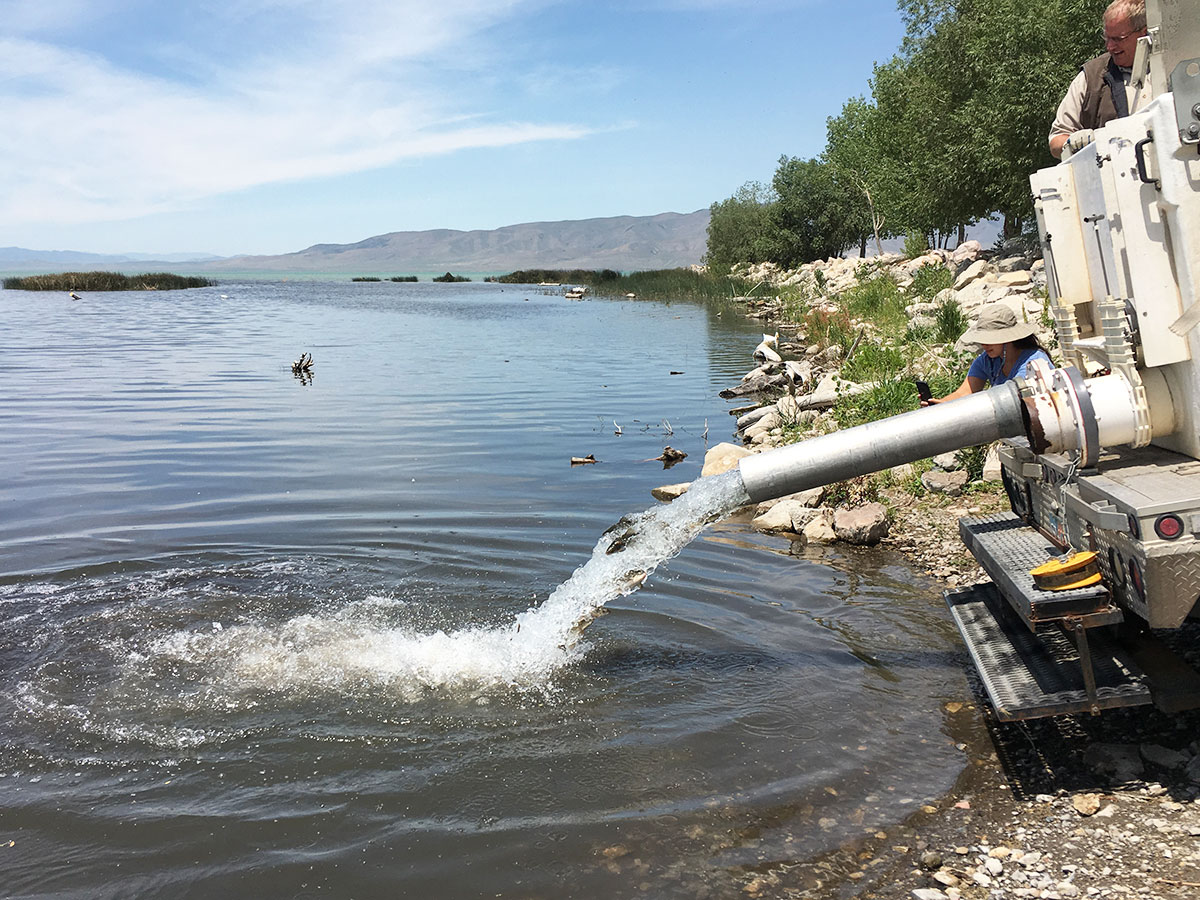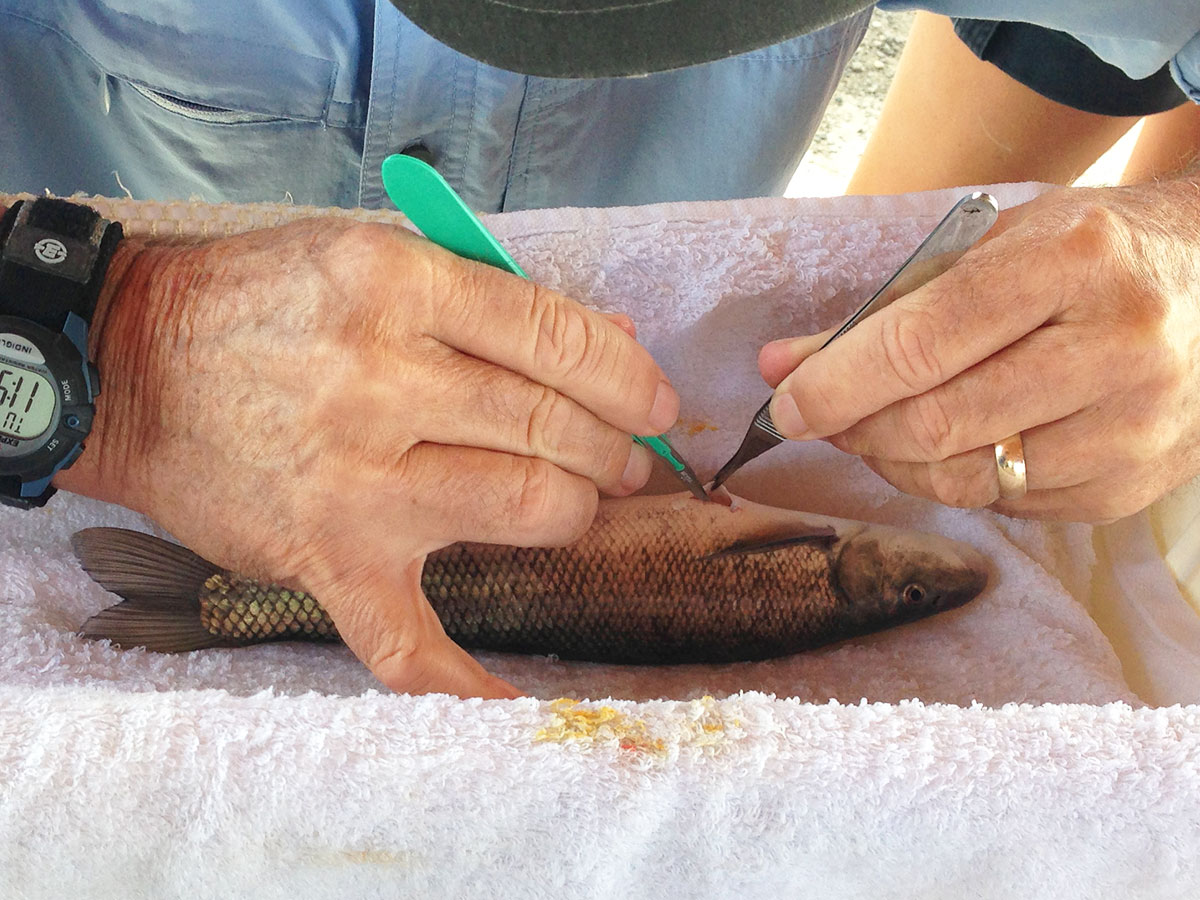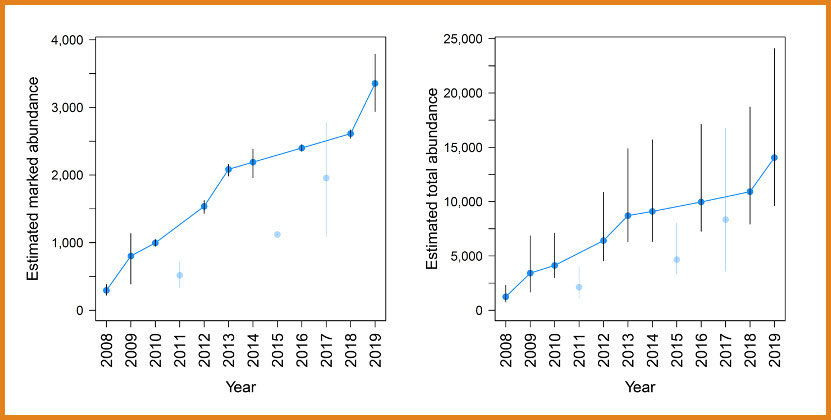
After the June sucker was listed as endangered, several efforts were made to help the June sucker increase its population through artificial spawning and stocking. Early efforts yielded mixed results in part because of misunderstanding the June sucker's survival needs.
The June Sucker Recovery Implementation Program has worked to understand June sucker biology, developing research opportunities while also stocking Utah Lake with hatchery fish to sustain the wild population of June sucker.
Growing the Population through Stocking
Following the June sucker's listing as an endangered species in the 1980s, wild adults were captured from the Provo River and artificially spawned to prevent extinction. The purpose of this effort was to develop a captive broodstock to breed June sucker in hatcheries. Considerable effort has been extended to ensure this broodstock represents, to the maximum extent possible, the genetic composition of the wild population.

This captive broodstock started providing young June sucker for placement, or stocking, into Utah Lake in the mid-1990s. Stocking efforts have increased over time, supported by the construction of a June sucker rearing facility in the early 2000s. Currently, approximately 25,000 June sucker are stocked into Utah Lake each year. Through carefully monitored data, these stocked fish have shown the ability to survive in the lake and contribute to increases in the June sucker population.
A self-sustaining population has been difficult for June sucker to achieve with less-than-ideal tributary access and many non-native predators. One main initiative of the June Sucker Recovery Implementation Program is stocking Utah Lake with hatchery-raised juveniles, a project that has proven to be a viable solution to June sucker recovery. Augmenting the wild June sucker population with 20 to 30 cm (8 to 12 in) June sucker raised at the Fisheries Experiment Station in Logan, Utah, has been going on since 2004.
Research Projects to Guide Recovery
As with most rare and sensitive species, little information on the basic biology and habitat needs of June sucker was known when the species was listed as endangered. The limited number of individual fish remaining in the wild and the altered environmental conditions of Utah Lake made research on June sucker difficult, but over the years, a variety of research projects on both captive and wild June sucker has increased the knowledge about what is needed to recover the species.
Results from these research projects have guided recovery actions, and the data generated from population-monitoring efforts has been used to determine the success of those actions. The primary research activity continues to be the annual monitoring of the June sucker population in Utah Lake and its associated tributaries.
Monitoring Post-Stocking Survival
To determine and measure the success of this effort, in July 2013, the JSRIP worked with Marsh & Associates, LLC, a company based out of Tempe, Arizona, that is dedicated to the conservation, recovery, and public education of imperiled native fishes of the desert southwest, initiated a three year study to assess the augmentation program and detail the immediate post-stocking survival and dispersal of hatchery-reared June sucker in Utah Lake.
Surveys using Acoustic Telemetry
To obtain survival estimates, Marsh & Associates conducted a series of intensive acoustic telemetry surveys. Overall, they released 40 June sucker implanted with acoustic telemetry tags over four different 60-day tracking periods in 2013 and 2014. They released ten more fish in June 2015 and a further 14 fish at the end of August 2015. The acoustic tags were implanted surgically by a seasoned team with extensive experience with razorback sucker, flannelmouth sucker, bonytail, and other native Colorado River fishes. The fish were first anesthetized using a chemical called Tricaine methanesulfonate (MS-222) and were then placed on a specially designed cradle where a small incision was made through which the tag was inserted. The incision was then sutured and the fish were given a dose of Baytril® (enrofloxacin) to prevent infection (see pictures).
The acoustic tags have a battery life of 90 days and transmit a unique underwater signal or ‘ping’ for each fish that can be picked up with hand-held or deployable hydrophones. Using this information surveyors can determine if a fish is still moving, if it’s stationary and presumed dead, or when it becomes lost to the study (i.e. tag failure or tag leaving the water), and then calculate survival estimates based on the fate of each individual fish.
Adding Passive Integrated Transponders to the Mix
In addition to the acoustic tags, approximately 3,600 fish, including 1,200 fish from captive populations in Springville and Box Elder County were stocked with passive integrated transponder (PIT) tags.

While acoustic telemetry tags can be detected over a broad range, their battery life limits them to a snapshot of what the fish are doing within the first 90 days of being stocked. PIT tags, on the other hand, are limited to localized detection, but can provide information indefinitely. Ideally when these young fish become sexually mature (3-5 years), they will swim up spawning tributaries where they will be detected by large PIT tag antennas placed in the water.
They may also be detected by smaller and more mobile PIT tag antennas that are deployed throughout the lake. This will provide long-term survival estimates of hatchery-raised fish and provide a better understanding as to how the population is reacting to recovery efforts.
The Results
Short-term survival of June sucker with telemetry tags was as high as 58% over a 60-day period in the summer of 2013 and was less than 20% over a 60-day period in the summer of 2014.
Survival estimates calculated from remote PIT tag antenna data will become more accurate as more fish are detected, but the mobile units have been successful in contacting fish. In the summer and autumn of 2013, a total of 69 contacts occurred in which there were 58 individual fish. In the summer of 2014, a total of 477 contacts occurred in which there were 263 individual fish.
![]()
One interesting behavior that has been observed while tracking these fish is that they are highly mobile throughout the lake, particularly in 2013 where all 20 fish moved a total of 1468 km (912 miles) based on tracking data. One such fish in 2013 moved a minimum of 308 km (191 miles) during the tracking period. This would be expected of larger adult fish but comes as a surprise for these smaller hatchery fish.
Causes of Mortality
The cause of post-stocking mortality of June sucker in Utah Lake is complicated and likely due to multiple factors. Utah Lake is home to a suite of non-native fish, with most focus being on northern pike, a species that was illegally introduced to Utah Lake and could predate on June sucker and impede their recovery. Bird predation may also be a major factor in the post-stocking survival of fish, as evidenced by the presence and documentation of California gulls consuming fish immediately post-stocking. It is almost certain that June sucker are also consumed by the abundant American White Pelican present on the lake.
In conclusion, telemetry has proven to be a valuable tool in providing short-term post-stocking survival estimates. JSRIP anticipates remote PIT scanning will continue to provide insight on long-term survival of June Sucker as these fish sexually mature and migrate up the rivers to spawn.
Monitoring the Adult Population
In addition to the Marsh and Associates studies monitoring immediate post-stocking survival and dispersal of hatchery-reared June sucker in Utah Lake, an important part of the JSRIP is monitoring their population trends over time. To accomplish this, the JSRIP and Utah Division of Wildlife Resources (DWR) are working in collaboration with Dr. Mary Conner, a researcher at Utah State University (USU). Dr. Conner uses a software package known as Program MARK and data on spawning June suckers collected by the DWR to estimate important parameters of the June sucker spawning population.
Making Use of PIT Tags
Also used in the Marsh and Associates studies, The DWR captures and implants June suckers with passive integrated transponders (PIT tags). Each PIT tag has a unique alpha-numeric code, allowing each tagged June sucker to be uniquely identified. The DWR places PIT antennas along the bottom of important tributaries for June sucker spawning. These include the Provo River, Hobble Creek, and the Spanish Fork River. When a fish with an implanted PIT tag swims over the antennas, the antennas detect it and store the information on a computer. The information can then be downloaded and used to estimate spawning population size, survival probability, and annual rate of population change. Dr. Conner estimates these parameters for the spawning population as a whole, combining all three tributaries. She has been able to use data collected since 2008 as part of this modeling effort.
The Results
Although the study is ongoing, some results are already in. So far, Dr. Conner has found that the spawning population has high probability of survival from year to year, with nearly 90% survival. Collectively, study results show that conservation and management efforts have driven high annual survival, and a substantial increase in abundance since 2008.

When considering the population estimates generated by this study it is important to remember that they apply only to the spawning population.
The total population in the lake is likely larger than the spawning populations in the tributaries due to individuals that are not yet mature or don’t spawn every year, possible in-lake spawning, or possible use of other tributaries for spawning.

{zen-file-pdf-o}{/zen-file-pdf-o} Download Dr. Conner's most recent report.
What We’ve Learned
Although increased sampling and additional years of data will improve these estimates, several important points can be learned from the study. First, high survival rates are encouraging for the recovery of June suckers. They indicate that once individuals reach spawning size, they remain in the population for a long time. In addition, based on the annual rate of population change estimates and the estimates of spawning population size, it appears that the spawning population of June suckers in Utah Lake is growing. Increasing the number of spawning June suckers is critical for the recovery of the species. Currently, this increase is primarily due to stocking efforts, but gives some hope that some natural reproduction may be occurring.
The results from this study are encouraging for June sucker recovery, but additional monitoring efforts are still needed. Future monitoring and recovery efforts will include ongoing monitoring of the spawning population, as well as pursuing methods to monitor the lake-wide population in addition to the spawning population. Monitoring the lake-wide population is more difficult because the geographic area is much larger; spawning adults must pass through bottle necks at the mouths of tributaries, making it easier to detect them. Although it appears that spawning June suckers have high probability of survival, the fate of larval and juvenile June suckers is far from certain. Juvenile June suckers have been collected sporadically at Hobble Creek. Juvenile monitoring efforts have been increasing since 2011 with the ultimate goal of understanding natural recruitment rate (versus increased population due to stocking efforts). These efforts, combined with population analysis similar to that described here will help guide the future of the JSRIP.
Special Thanks to...
- Division of Wildlife Resources












